
Andy Lloyd's Dark Star Blog

Blog 11 (February 2014)
A Red Brown Dwarf
A brown dwarf with unusually red skies has been discovered by a team of astronomers from the University of Hertfordshire's Centre for Astrophysics Research.
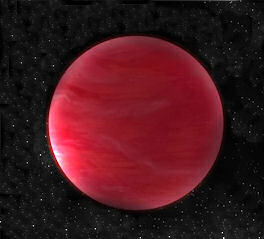
The brown dwarf, named ULAS J222711-004547, caught the researchers' attention for its extremely red appearance compared to "normal" brown dwarfs. Further observations with the VLT (Very Large Telescope) in Chile have shown that the reason for the unusually red colour is the presence of a very thick layer of clouds in its upper atmosphere. (1)
Federico Marocco, who led the research team, said:
"These are not the type of clouds that we are used to seeing on Earth. The thick clouds on this particular brown dwarf are mostly made of mineral dust, like enstatite and corundum."
The atmosphere observed in this particular brown dwarf is hotter than in known gas giants, with water vapour, methane and probably some ammonia but, unusually, it is dominated by clay-sized mineral particles. These significantly-sized dust particles create the reddening effect as light passes from the interior of the brown dwarf through the clouds in its upper atmosphere.
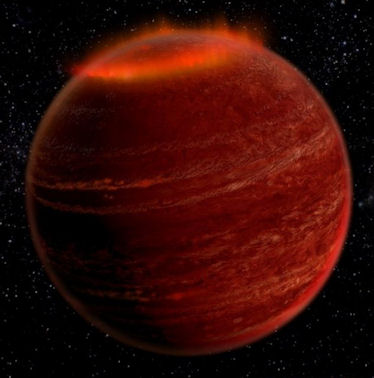
The astronomers estimate that this object is an small, ultra-cool L-dwarf. Brown dwarfs this small should not be a red as this, which is the reason why they have posited the atmospheric model described in their press release. In the scientific paper's abstract they go on to explain their thinking in more detail:
"Comparison to theoretical models suggests that the object could be a low-gravity L dwarf with a solar or higher than solar metallicity. Nonetheless, the match of such fits to the spectral energy distribution is rather poor, and this and other less red peculiar L dwarfs pose new challenges for the modelling of ultracool atmospheres, especially to the understanding of the effects of condensates and their sensitivity to gravity and metallicity." (2)
For readers interested in the solution to the 'Nibiru' enigma, I think this adds some further grist to the mill in that it shows how a very reddened, but cool sub-brown dwarf might fit the bill.
Andy Lloyd, 15th February 2014
References:
1) University of Hertfordshire Press Release "Red skies discovered on extreme brown dwarf" 6 Feb 2014
2) F. Marocco, A. C. Day-Jones, et al. "The extremely red L dwarf ULAS J222711−004547 – dominated by dust", Monthly Notices of the Royal Astronomical Society, 439(1): 372–386, 21 March 2014
mnras.oxfordjournals.org article
Asteroid Belt was Significantly Shaken Up - Official
Astrophysicists from MIT studying the composition and spread of 100,000 asteroids in the extended main belt between Mars and Jupiter have been surprised by the diversity of objects across its various layers, and beyond. This might sound a rather dry, academic observation, but it has far-reaching consequences about the forces shaping the early solar system. Essentially, the asteroid belt is a far more dynamic place than was previously thought, indicating that large-scale migrations must have taken place through the early solar system.
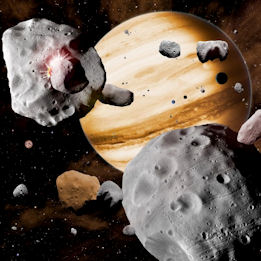
In fact, the researchers who conducted this work go further - proposing that Jupiter must have swept through the asteroid belt some time in the distant past, as part of some kind of migratory pattern:
"The compositional diversity seen in this new asteroid map may add weight to a theory of planetary migration called the Grand Tack model. This model lays out a scenario in which Jupiter, within the first few million years of the solar system’s creation, migrated as close to the sun as Mars is today. During its migration, Jupiter may have moved right through the asteroid belt, scattering its contents and repopulating it with asteroids from both the inner and outer solar system before moving back out to its current position — a picture that is very different from the traditional, static view of a solar system that formed and stayed essentially in place for the past 4.5 billion years.
"“That [theory] has been completely turned on its head,” DeMeo says. “Today we think the absolute opposite: Everything’s been moved around a lot and the solar system has been very dynamic.”" (1)
If it was Jupiter causing this mayhem, then the effect would have been truly cataclysmic, as the website Universe Today noted:
"When Jupiter migrated, it disturbed everything in its wake and possibly removed as much as 99.9 per cent of the original asteroid population. And other planet migrations in general threw in rocks from everywhere into the asteroid belt. This means the origin of water in the belt could be more complicated than previously believed." (2)
What a contrast to the thinking a couple of decades ago! When ideas about rogue planets sweeping through the solar system were mooted in the past, either in the form of the Nemesis theory, or Zecharia Sitchin's planet Nibiru, mainstream sceptics were quick to point out how stable the solar system is, and how that status would not be possible if catastrophic passages of such planets had taken place. They cited mechanistic hypotheses such as the Kosai effect to prove their point.

Yet, now we have scientists at the forefront of solar system studies demonstrating that the migration of massive planets through the solar system are actually necessary for the solar system to have taken on the compositional appearance it has today!
There is no symptomatic difference between a sweep of Jupiter and the sweep of a rogue sub-brown dwarf through, or close to the asteroid belt. Indeed, the advent of a rogue Dark Star in the midst of the solar system makes rather more sense.
Andy Lloyd, 15th February 2014
References:
1) Jennifer Chu "‘Rogue’ asteroids may be the norm: A new map of the solar system’s asteroids shows more diversity than previously thought", MIT News Release, 29 January 2014
2) Elizabeth Howell "Earth’s Water Story Gets A Plot Twist From Space Rock Search" 30 January 2014
Now for the Weather - on our nearest known Brown Dwarf
You may not be aware of this, but the closest known brown dwarf - actually a binary brown dwarf pair - is a mere 6 light years away, making this the third nearest star system to us. Joining such well-known neighbours as Alpha Centauri and Barnard's Star, this brown dwarf couple languishes under the ignominious title of WISE J104915.57-531906.1B, although sensible astronomers prefer Luhman 16AB (after the American astronomer who discovered the pair using the WISE survey in 2013).
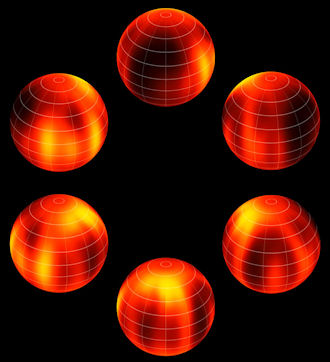
Interestingly, Luhman 16AB appears in the sky close to the galactic plane, which is densely populated by stars, where the abundance of light sources makes it difficult to spot faint objects (1). This explains why an object so near to the Sun was not discovered in earlier searches, a point that I have made many times about the potential for finding even closer sub-brown dwarfs in constellations like Sagittarius.
Once again, the Very Large Telescope has been in action, this time imaging Luhman 16B (which may be a T-type dwarf). The detail of the images (right) is sufficiently good to be able to make out the changing patterns in the appearance of the brown dwarf, driven by the weather in its upper cloud layers. It has also enabled scientists to establish that Luhman 16B's 'day' is 4.9 hours long.
Ian Crossfield (Max Planck Institute for Astronomy, Heidelberg, Germany), the lead author of the new study, notes:
“Previous observations suggested that brown dwarfs might have mottled surfaces, but now we can actually map them. Soon, we will be able to watch cloud patterns form, evolve, and dissipate on this brown dwarf..." (2)
This is helpful to astronomers trying to understand brown dwarfs better because they will be able to model how the cloud structures alter with temperature, and how the dispersal of dust within those cloud layers occurs. Models to explain this dust dispersal include both an abrupt sinking of the entire cloud deck into the deep, unobservable atmosphere of the brown dwarf, and a breaking up of the cloud into scattered patches (3). The cooler the brown dwarf, the more the dust settles out of the atmosphere - which is why the dust-induced reddening noted in the first article above is so puzzling for an L-type dwarf.
Andy Lloyd, 15th February 2014
References:
1) "Luhman 16"
2) ESO Press Release "First Weather Map of Brown Dwarf" 29 January 2014, with thanks to David
3) I. Crossfield, et al. "A Global Cloud Map of the Nearest Known Brown Dwarf"
Mesopotamian Aliens?
Some startling new images of ancient Mesopotamian artefacts once again hint at ancient encounters with aliens. The object opposite was photographed in the National Museum of Iraq in Baghdad by an intrepid adventurer whose tongue-in-cheek blog ponders that very possibility. The writer indicates that this pottery may be as ancient at 6000 years old.
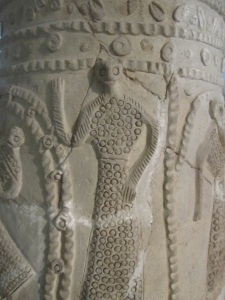
It bears more resemblance to the mythical half-fish Oannes than to the Sumerian Anunnaki, at least to my eyes - although many consider the Anunnaki to have a reptilian quality about them. Check out the link below for more examples of alien art from Iraq, complete with some cracking commentary.
Andy Lloyd, 15th February 2014
Reference:
Paula Froelich "Oh, So THIS Is What ET Looks like: Proof Of Ancient Aliens In Baghdad" 27 January 2014, with thanks to Lee
Russian Stone Circles
Continuing our occasional series about the widespread occurrence of enigmatic stone circle corrals, initially described by author Michael Tellinger. The reader may recall how similar structures have been photographed in the Syrian deserts (right, top). Lee Covino has now come across a discussion of a similarly-shaped ancient stone circle - this time in Russia.

The difference is in the scale, as the original stone structure which held sway over this landscape covered an area of some 200,000 square feet. A winding street separates two concentric circle of buildings (right, below). This monumental ancient structure set in the South Urals, and known as Arkaim, has attracted great interest, particularly as a result of its unusual shape, which some consider to be Swastika-like.
"The site was discovered (rediscovered?) in 1987 by a team of Russian archaeologists, and a wave of excitement washed through the world of archaeology. The site and associated artefacts have been dated to the 17th century BCE ..." (1)
So who built Arkaim, and might the structure be linked to the rather more primitive, but extensive stone-works of Africa and Syria?
"The 17th century date suggests that the settlement was about coeval to, or just post-dating, the Indo-Aryan migration into South Asia and Mesopotamia (the Gandhara grave culture appearing in the Northern Pakistan from ca. 1600 BC, the Indo-European Mitanni rulers reached Anatolia before 1500 BC, both roughly 3,000 kilometres (1,900 mi) removed from the Sintashta-Petrovka area), and that it was either an early Iranian culture, or an unknown branch of Indo-Iranian that did not survive into historical times". (2)
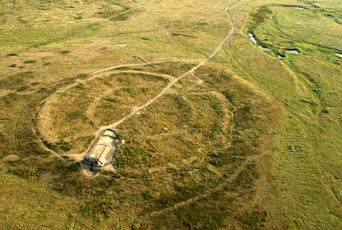
The swastika theme plays well with the probable Aryan nature of the site's builders. But the site also lends itself to archeo-astronomy studies, too. It's fair to say that here's more mystery here than answers, beyond the emerging realisation that ancient cultures diffused widely across continents, inter-mixing and blending as they went along.
Andy Lloyd, 15th February 2014
References:
1) Martin Clemens "Arkaim: Russia’s Stonehenge and a Puzzle of the Ancient World" 31 January 2014 with thanks to Lee
mysteriousuniverse.org article
2) "Arkaim"
Hercolubus and Carlos Muñoz Ferrada
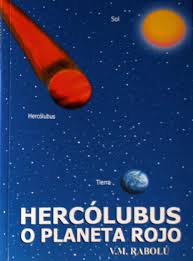
Some correspondence about the red planet Hercolobus, from João Espadinha (dated 9/1/14):
Hi Andy,
Have you heard about a supposedly Chilean astronomer supposedly named Carlos Ferrada? He supposedly predicted a dark star twin sun type object many years ago, but particularly interesting is that he talks about another object he calls “Hercolobus” which is a planet that orbits between the dark star and our sun. It’s said that he even calculated their orbits.
Eerily familiar, right?
Best regards,
Joao
~~ * ~~
Hi Joao,
Thanks for this info. I was once presented with a little book called' Hercolubus or Red Planet' by a couple of chaps at a Planet X conference, who seemed to belong to some kind of organisation. I have it in front of me - written by V M Rabolu. Once it started talking about Venusians, I knew their game was up, but your info seems to be of a more concrete nature, albeit historical.
Many thanks,
Andy Lloyd
~~ * ~~
Heya,
Yeah, I’ve heard about that little book and the organization that spreads it, they are still around and have a website somewhere where one can send a request and they will ship that little book anywhere in the world for free (http://hercolubus.tv/)
I’ve searched around for info about Ferrara, the supposed astronomer from Chile, and from what I understand the people behind that book took the ideas of Ferrara and built a kind of gnostic organization around them with elements of scifi/biblical end of times preaching. They are not directly related from what I can tell but are both from Chile or country in South America. Their founder was some kind of self-entitled prophet or visionary whatever.
Did you see Ferrara’s video on Youtube (on the webpage noted above)? Crazy stuff. What made me pay attention and what stood out ... is the clear differentiation between the dark star, which he calls black star if I’m not mistaken, and the Hercolobus that has the weird binary orbit. Even the drawing the men is showing reminds me of the drawing you did on your book. Creepy stuff man!
Best regards,
João
Here's some of the core information from the link João sent me:

Carlos Muñoz Ferrada
"CHARACTERISTICS OF HERCOLUBUS ACCORDING TO CHILEAN ASTRONOMER CARLOS MUÑOZ FERRADA:
It is a red planet which presents an elliptical orbit of a comet and great mass of a planet, in other words “a planet with a tail” .
The star is charged with cosmic energy, as to say rarefied radiation which according to scholars alter the behavior and health, and will provoke incurable epidemics and irritability, bringing wars.
Does not meet the conventionally established celestial physical laws.
Travels between our Sun and a Black Sun which is found 32 trillion kilometers away.
Will pass 14 million kilometers from Earth./li>
It is approximately 6 times bigger [more massive?] than Jupiter, thus its approach of 14 million kilometers from our world will exercise a disastrous attraction up on the incandescent liquid minerals inside the Earth, provoking tremendous internal pressures and therefore volcanoes and earthquakes.
It will end up penetrating our Solar System and be visible to the naked eye as well as photographed.
“Its arrival will cause human and geophysical change, bringing change and destruction”.
"On June 28th, 1999, on Channel 4 on the Television of Puerto Rico, after 50 years of investigation and scientific documentation, the great Chilean Astronomer, at 90 years of age, revealed with absolute precision the three velocities that Planet X has in its orbit. Its velocity as it passes close to the dead Sun or the black star, another in the middle of its elliptical orbit and a third as it passes close to our sun, to a thousandth of the speed of light, and 14 million kilometers from Earth."
Reference: Vopus "Tribute to the memory and work of the great Chilean astronomer CARLOS MUÑOZ FERRADA" (article on longer available on line)
Once again, I am struck by the date 1999. This is the same year that Dr Murray in England and Professor Matese in the U.S. independently wrote scientific papers proposing the existence of a 'planet' of a similar mass to the one cited in this article. My whole interest in this subject also began around this time, as I began writing about a possible link between such a sub-brown dwarf body and Zecharia Sitchin's Nibiru. As João says, most eerie indeed!

The inauguration of Panama’s observatory concluded with a fireworks display, in 2011
But a word of caution - when I tried to look into the professional and academic credentials described for Carlos Muñoz Ferrada I quickly encountered a problem. He is widely described on the Internet as having been "a director of the Astronomical Observatory of Panama for five years". Yet, when I tried to find out more about this observatory, and its historical directors, I discovered that Panama's first official Astronomical Observatory only opened in 2011!
Reference: Karri Ferron "Panama inaugurates its first astronomical observatory" 31st May 2011
Carlos Muñoz Ferrada died in 2001. So, I'm a bit confused. It appears as though he moved through several countries - in Europe, Central and South America - before settling in Chile, so it is entirely possible that he ran his own observatory in Panama along the way, which essentially became Panama's first unofficial observatory. But that might not be quite as prestigious a role within the astronomical community as the article implies. Similarly with membership of various Astronomical Societies. Nevertheless, that's not to say that he didn't make a strong contribution to astronomy in general, even if he was an amateur rather than professional astronomer.
Andy Lloyd, 15th February 2014
Billy Meier's Dark Star

Swiss Contactee Billy Meier claims to have had a lifetime of experiences with aliens. His direct contact episodes in 1975 produced some of the most famous UFO photos ever. He has compiled a mass of material from the conversations he claims to have had with his alien contacts. The following short extract is a translation from a German transcript of a conversation which took place in September 2012 between Billy and an alien he knows as Ptaah.
In this exchange, Ptaah describes the Dark Star (in German - Dunkelstern), indicating that it is a Nemesis-like object at the far-flung edges of the solar system. It is distinct from another rogue object - a 'dark planet' (in German - Dunkelplaneten), which is presumably Nibiru:
"Billy: I would rather have you explain something to me a little more precisely: actually why, for some time now, enormous changes take place in the Oort cloud, which is located just at the outermost edge of the SOL system, as you explained to me in a conversation on my Great Trip in 1975, when you permitted me to see the Dark Star. In one of our most recent conversations you also again privately indicated something regarding the changes taking place in the Oort cloud. You said that, due to the dark planet floating around out there, changes are taking place that will influence the whole SOL system. To my knowledge, the terrestrial scientists suspected something along these lines, that the Dark Star exists out there, but, for them, everything is based on pure conjecture. To my knowledge, they use the name Nemesis for the alleged Dark Star. But the whole thing has nothing to do with the dark planet, which moves along its trajectory on the other side of the Sun and cannot be perceived from the Earth and haunts through the system, because I think that this has nothing to do with the Dark Star, Nemesis, or?
Ptaah: That is right. The SOL system is a binary star system, where the SOL twin is a so-called Dark Star, as you say. Its size is about ten times smaller than the SOL itself, whereby this twin also has its own planets orbiting around it, as you have known since 1975. The radius of the Dark Star to the SOL encompasses more than a light-year, therefore, more than 9.5 trillion kilometres, and the circumnavigation of the SOL’s centre of mass, that is to say, SOL's own orbit, amounts to around 26 million years.
Billy: SOL’s own orbit – I do not understand. What does that mean?
Ptaah: The Sun, that is to say, SOL does not stand still in outer space; rather it turns, indeed in its own sweeping circle, around an imaginary midpoint.
Billy: Aha. I did not know that. And why, so far, have the terrestrial astronomers not yet discovered the Dark Star?
Ptaah: The hitherto existing astronomical technical equipment and devices are still not suitable. But it is only a question of time until a corresponding discovery occurs. The currently existing technical devices are not yet capable, however, of capturing the extremely faint light of the Dark Star and its satellites. And regarding that, to which the changes relate, in the Oort cloud, evoked by the Dark Star; the basis is that an enormous movement occurs in the innumerable – existing in billions – numbers of smallest, small, large and largest rock, ice and metal fragment formations, and sometimes great structures are hurled out as meteors from the Oort cloud, into orbits of the inner SOL system. A large chain of such meteors is, already for many decades, underway into the inner SOL system and has partly already passed the Earth or exploded high in its atmosphere. This is happening because of the Dark Star which has long since penetrated directly into the effective range of the Oort cloud, and since then evokes severe disturbances." (1)
It might be worth pointing out here that a German translation of my book 'Dark Star' was published in 2009, its title 'Dunkelstern' (2). Although it is no longer in print, I still have some brand new copies available.
'Ptaah' places the Dunkelstern a light year away, which is absolutely at the farthest extent of the Sun's influence. Such a mighty distance is a credible possibility in terms of trying to understand how such a large brown dwarf object has gone undetected for so long. But at that distance it would have little, if no influence upon what we recognise as the solar system. Nevertheless, I'm intrigued by this piece of writing, and am grateful to Barry Warmkessel for posting details about it to the Dark Star Planet X Google group.
Andy Lloyd, 16th February 2014
Reference:
(1) Billy Meier "Contact Report 544" translated by Dyson Devine 9 January 2013 with thanks to Barry
2) Andy Lloyd "Dunkelstern: Planet X Die Beweise" Translated by Andreas Zantop, Kopp Verlag, 2009
![]() Dunkelstern: Planet X - die Beweise
Dunkelstern: Planet X - die Beweise
Crazy Weather
It seems most of the world seems to be experiencing extreme weather of some form or another this winter (or summer in ultra-hot Australia). Here in Britain, we've had a run of storms driven off the Atlantic that have progressed fairly non-stop for what must be a couple of months now. It's brought record rainfall to southern Britain, damaging winds, especially along the coastline, and extensive river flooding.

In 2007, the area I live in was affected by a summer downpour that could only be described as Biblical in extent. As a result, the River Severn flooded a wide region of Gloucestershire, causing flooding in over 50,000 homes, and immense disruption to maybe half a million people. This year's floods have not been as bad, although having occurred just 7 years since the last lot, it's getting to be a bit more common an event. Which is worrying.
So, is this the result of Global Warming? Are we starting to experience a greater frequency of extreme weather events attributable to man-made greenhouse gases? The events across southern Britain this year have certainly served to rekindle that debate. I don't know the answer any more than anyone else, and don't pretend to. If the worse fears are realised, then we will need to be pretty ingenious, as well as highly pragmatic, to deal with what's coming. You could argue we're getting some useful practice in early.
Anyway, here are some photos from the bottom of my street yesterday, and the playing fields close by, to give you a sense of what our winter has felt like (courtesy of the local rag 15 February 2014).

Such was the extent of the flodding, Prime Minster David Cameron visited my local pub on Monday 17th February to meet flood victims.
On Tuesday 18th February, I took part in the 'Call You and Yours' programme on BBC Radio 4, when I discussed the floods in my area, and how there are still building plans afoot to build across the River Severn floodplain north of Gloucester. I made the point that the alternative of building housing estates in the picturesque Cotswolds in Gloucestershire would generally be less acceptable an option to most people than extending the City of Gloucester across the floodplain, so these decisions are never easy. Nevertheless, to still build across flood-prone fields near Longford defies common sense, whatever the need for new housing in the county.
Yasmeen's Painting
On a brighter topic, some time ago, I painted a figurative portrait of Yasmeen, a model from the West Coast of the USA. Although Yasmeen has worked with many terrific photographers, having her painting done was a more unusual collaboration, and through the social networking site Model Mayhem she has always been very supportive of both my artwork and most specifically this painting.

Well, the painting is now in her possession, I'm very happy to say, and she has sent me a couple of images of the framed painting taking pride of place in her home. I think you'll agree they are stunning photos, and I am absolutely delighted that this collaboration has worked out so well.
Andy Lloyd, 24th February 2014

You can keep informed of updates by following me on Twitter:
![]()
Or like my Facebook Page: https://www.facebook.com/darkstarandylloyd